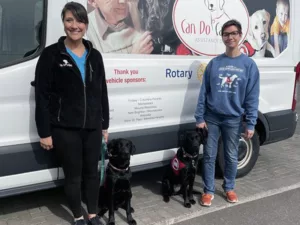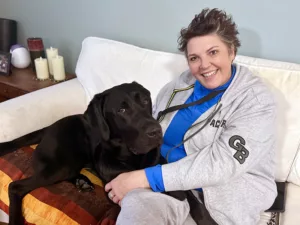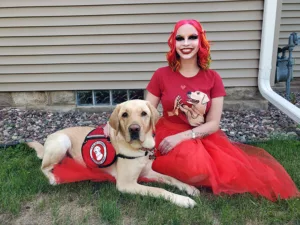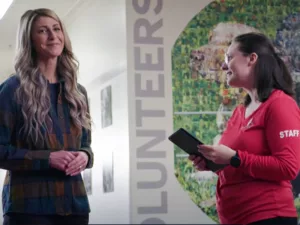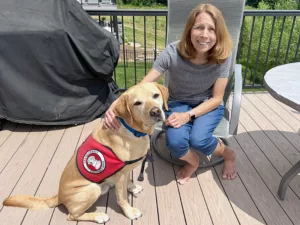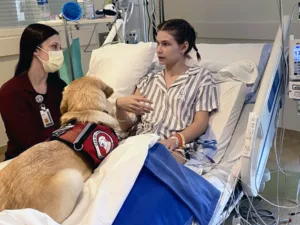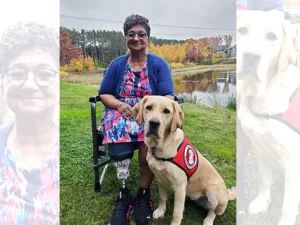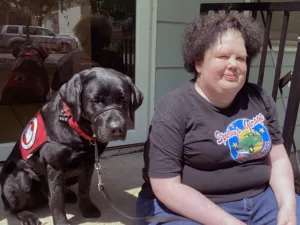On Thursday, March 14, Can Do Canines transported two assistance dogs in training, Crombie and Penny, to their temporary home at the Faribault Correctional Facility. A pair of selected inmate handlers will live with and provide 24/7 care to each of these two 1-year-old black Labrador Retrievers. Additionally, a Can Do Canines staff member will make weekly visits to the facility, providing training instruction to the inmate handlers, who will help the dogs learn obedience skills and basic assistance dog skills. Can Do Canines currently partners with seven other prisons in Minnesota and Wisconsin: Duluth, Rochester, Sandstone, and Waseca, Minn., …
assistance dogs
Feeding Equipment Options for Dogs
Make no bones about it, mealtime is often a favorite activity for dogs. With the right equipment, mealtime can be not only a hit with your dog, but it could bring other benefits, as well. First of all, let’s dish about dishes. Both food and water bowls have varieties you might want to consider. A slow-feeder food bowl* is great for dogs who gulp their food quickly, sometimes even causing themselves to be sick. These bowls that often look like they have a maze inside do, in a way, put the dog’s tongue in a maze to investigate all the …
Lambeau Leaps into Nora’s Life
Nora grew up in Southern Ohio. Her dad played semi-pro football, and she quickly became a fan of the game, going to Cincinnati Bengals games and college matchups. When she was 14, her family moved to Minnesota, but Nora struggled to embrace her new state’s pro team. Her perception of fan commitment, along with sitting inside the 70-degree Metrodome, didn’t work for her. “You’re not supposed to take your coat off when you go to a football game. That’s just backwards. We’re in Minnesota. So I really didn’t vibe with the whole Viking thing.” A few years later, she entered …
Open House: May 18, 2024
We will be hosting an open house on Saturday, May 18, from noon-2 p.m., at our campus. Potential clients, volunteers, or anyone who might be interested in supporting the organization is invited to attend to learn how an assistance dog changes the life of a person with a disability. There is no pre-registration for this event, so please join us on May 18. You will be asked to share some contact information at our registration table upon arrival. To request a sign language interpreter for the Open House, please contact Laurie at lcarlson@candocanines.org or call 763-331-3000 at least two weeks in advance. We’ll do …
Qantas is Making Life Easier for Bethany
By Beth Billstrom – In 2022, Bethany experienced a horrifying seizure brought on by a stroke. Unbelievably, her then five-year-old daughter was home and knew how to call EMS. Bethany states, “She helped me through until the emergency medical team arrived. I’m so grateful to her, but she’s a child. I needed a different plan.” Although she feels lucky that her husband and daughter are willing to help her, she knows her conditions are stressful for them, too. “They always worry about me,” admits Bethany. “They need to go to work and school, so being left by myself is scary …
We’re Excited to Share Our New TV Commercial
Just when some companies were preparing to air their multi-million-dollar advertisements during the Super Bowl, we were producing a professional TV commercial of our own (though not for the Super Bowl)! During the Fetching Ball program, we previewed the 30-second spot. Check it out here.
Uzi Brings Help and Happiness to Diane’s Life
“Living with chronic pain can be so isolating,” says Diane, who was born with a hip defect and diagnosed with scoliosis in junior high. When she later had children, her pregnancies caused her symptoms to progress, prompting multiple hip surgeries. Now, with rods in her spine and the onset of psoriatic arthritis, she states, “I have a lot of nerve pain that doesn’t go away.” In her mid-40s, she had to quit her job as a hospital lab technician to focus on managing her pain. She began using a cane and despite the medicines she was taking, Diane says that …
Facility Dog Program Becomes Official
At the January board meeting, our Board of Directors voted unanimously to make our Facility Dog pilot program permanent. A facility dog is trained to work at a designated location with a variety of people. Typically, this type of dog is placed in a hospital or a rehab center. Like our other dogs, Facility Dogs are task-trained, but the tasks they perform are done for someone other than their handler. We have placed several certified dogs in facilities over the years, most notably four in each of the last two years, as we explored this approach. We will limit the …
Karen Falls in Love with Mobility Assist Dog Ulla
“I used to fall 2 or 3 times a week,” says Karen, referring to the effects of having her leg amputated below the right knee in 2020. In late 2013, a joint in Karen’s foot collapsed, prompting a series of reconstruction surgeries—several of which were unsuccessful. She then developed type 2 complex regional pain syndrome, a neurological condition associated with intense or prolonged pain. By the time the amputation was necessary, mobility was a real challenge. “I had not walked in six years, Karen explains. “It was like having to learn how to walk again, and now I’m having an …
Ruby Aims to Make More Red-Letter Days for Tiffany
Tiffany says of her Can Do Canine, Ruby, “I fell in love with her the first time I saw her.” Tiffany has had dogs all her life, but never one with a black spot on their tongue, and not a skilled assistance dog before. Ruby, though, is committed to proving her worth. This beautiful black Lab has been trained for both hearing and mobility assistance to help Tiffany deal with symptoms caused by a 2020 traumatic brain injury. The risk of falling and hurting herself when bending over is one of Tiffany’s biggest fears, so Ruby is happy to pick …

